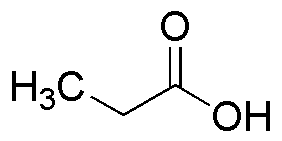Propionic acid is widely utilized in research focused on:
- Food Preservation: As a natural preservative, it helps inhibit mold and bacteria growth in baked goods and dairy products, extending shelf life and ensuring food safety.
- Agriculture: Used in herbicides and fungicides, it effectively protects crops from pests and diseases, promoting healthier yields and reducing reliance on synthetic chemicals.
- Pharmaceuticals: It serves as a building block in the synthesis of various pharmaceuticals, enhancing drug efficacy and stability in formulations.
- Animal Feed: Added to livestock feed, it aids in digestion and improves nutrient absorption, leading to better growth rates and overall animal health.
- Bioplastics: Employed in the production of biodegradable plastics, it contributes to sustainable materials that reduce environmental impact compared to traditional plastics.
General Information
Properties
Safety and Regulations
Applications
Propionic acid is widely utilized in research focused on:
- Food Preservation: As a natural preservative, it helps inhibit mold and bacteria growth in baked goods and dairy products, extending shelf life and ensuring food safety.
- Agriculture: Used in herbicides and fungicides, it effectively protects crops from pests and diseases, promoting healthier yields and reducing reliance on synthetic chemicals.
- Pharmaceuticals: It serves as a building block in the synthesis of various pharmaceuticals, enhancing drug efficacy and stability in formulations.
- Animal Feed: Added to livestock feed, it aids in digestion and improves nutrient absorption, leading to better growth rates and overall animal health.
- Bioplastics: Employed in the production of biodegradable plastics, it contributes to sustainable materials that reduce environmental impact compared to traditional plastics.
Documents
Safety Data Sheets (SDS)
The SDS provides comprehensive safety information on handling, storage, and disposal of the product.
Product Specification (PS)
The PS provides a comprehensive breakdown of the product’s properties, including chemical composition, physical state, purity, and storage requirements. It also details acceptable quality ranges and the product's intended applications.
Certificates of Analysis (COA)
Search for Certificates of Analysis (COA) by entering the products Lot Number. Lot and Batch Numbers can be found on a product’s label following the words ‘Lot’ or ‘Batch’.
*Catalog Number
*Lot Number
Certificates Of Origin (COO)
This COO confirms the country where the product was manufactured, and also details the materials and components used in it and whether it is derived from natural, synthetic, or other specific sources. This certificate may be required for customs, trade, and regulatory compliance.
*Catalog Number
*Lot Number
Safety Data Sheets (SDS)
The SDS provides comprehensive safety information on handling, storage, and disposal of the product.
DownloadProduct Specification (PS)
The PS provides a comprehensive breakdown of the product’s properties, including chemical composition, physical state, purity, and storage requirements. It also details acceptable quality ranges and the product's intended applications.
DownloadCertificates of Analysis (COA)
Search for Certificates of Analysis (COA) by entering the products Lot Number. Lot and Batch Numbers can be found on a product’s label following the words ‘Lot’ or ‘Batch’.
*Catalog Number
*Lot Number
Certificates Of Origin (COO)
This COO confirms the country where the product was manufactured, and also details the materials and components used in it and whether it is derived from natural, synthetic, or other specific sources. This certificate may be required for customs, trade, and regulatory compliance.


